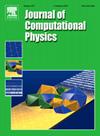A matrix-free stabilized solver for the incompressible Navier-Stokes equations
IF 3.8
2区 物理与天体物理
Q2 COMPUTER SCIENCE, INTERDISCIPLINARY APPLICATIONS
引用次数: 0
Abstract
We present an efficient solver for the incompressible Navier-Stokes equations implemented in a matrix-free fashion. It uses a higher-order continuous Galerkin finite element method for the space discretization and leverages a stabilized formulation that includes both the SUPG and PSPG terms. We solve the non-linear problem in a fully coupled way, using a Newton-Krylov method, which is preconditioned by a monolithic geometric multigrid solver. To evaluate its efficiency in terms of time to solution and scalability on modern high-performance computers, we use a manufactured solution, a steady flow around a sphere with Reynolds number and the Taylor–Green vortex benchmark at . The results indicate that the solver is robust and scales for both steady-state and transient problems. We compare the matrix-free solver to a matrix-based version and show it exhibits lower memory requirements, better scalability, and significant speedups (10–100 for higher-order elements). Moreover, we demonstrate that a matrix-free implementation is highly efficient when using higher-order elements, which provide higher accuracy at a lower number of degrees of freedom for complex steady problems. To the best of our knowledge, this work is the first that uses a matrix-free monolithic geometric multigrid preconditioner to solve the stabilized Navier-Stokes equations. All implementations are available via the open-source software Lethe.

不可压缩Navier-Stokes方程的无矩阵稳定求解器
我们提出了一个以无矩阵方式实现的不可压缩Navier-Stokes方程的有效求解器。它使用高阶连续Galerkin有限元法进行空间离散化,并利用包含SUPG和PSPG项的稳定公式。我们用牛顿-克雷洛夫方法以全耦合的方式求解非线性问题,该方法以单块几何多网格求解器为前提。为了评估其在求解时间和现代高性能计算机上的可扩展性方面的效率,我们使用了一个制造的解决方案,即雷诺数Re=150的球体周围的稳定流和Re=1600的Taylor-Green漩涡基准。结果表明,该算法具有较强的鲁棒性,适用于稳态和瞬态问题。我们将无矩阵解算器与基于矩阵的解算器进行比较,发现它具有更低的内存需求、更好的可扩展性和显著的加速(高阶元素的10 - 100倍)。此外,我们证明了当使用高阶元素时,无矩阵实现是高效的,它在较低的自由度下为复杂的稳定问题提供了更高的精度。据我们所知,这项工作是第一次使用无矩阵的整体几何多网格预调节器来求解稳定的Navier-Stokes方程。所有的实现都可以通过开源软件Lethe获得。
本文章由计算机程序翻译,如有差异,请以英文原文为准。
求助全文
约1分钟内获得全文
求助全文
来源期刊

Journal of Computational Physics
物理-计算机:跨学科应用
CiteScore
7.60
自引率
14.60%
发文量
763
审稿时长
5.8 months
期刊介绍:
Journal of Computational Physics thoroughly treats the computational aspects of physical problems, presenting techniques for the numerical solution of mathematical equations arising in all areas of physics. The journal seeks to emphasize methods that cross disciplinary boundaries.
The Journal of Computational Physics also publishes short notes of 4 pages or less (including figures, tables, and references but excluding title pages). Letters to the Editor commenting on articles already published in this Journal will also be considered. Neither notes nor letters should have an abstract.
 求助内容:
求助内容: 应助结果提醒方式:
应助结果提醒方式:


